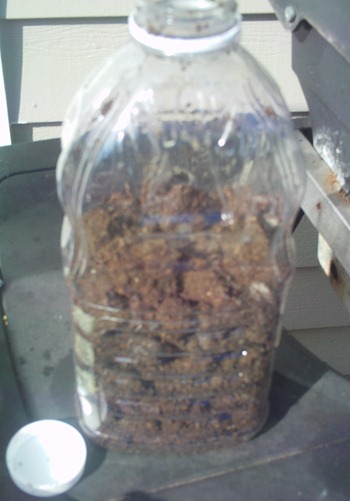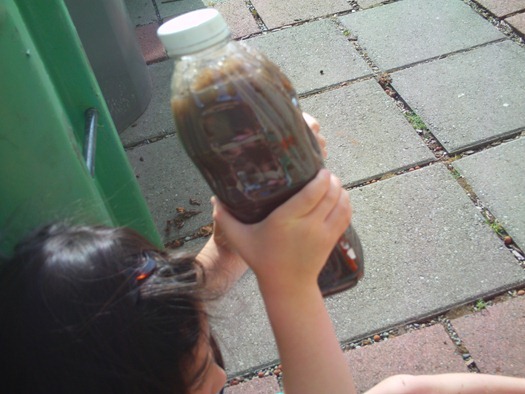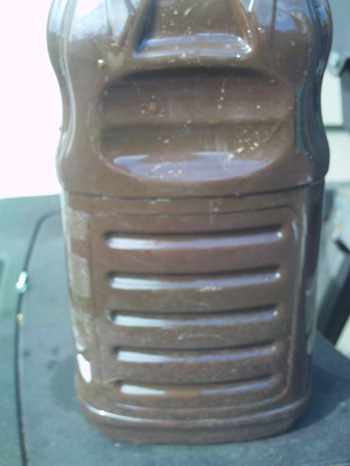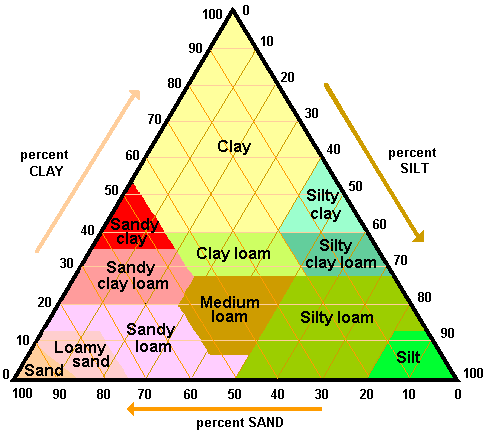Molecular composition of DIRT
11 years ago chemistry, dirt, soil composition

While walking down the hallways at work I noticed a coworker with a caffeine molecular T-Shirt and made me think of the question, “What does a simple spec of dirt look look?” I know my brain works in weird ways…but anyway what I found was pretty amazing. Above is what an average molecule’s chemical composition looks like.
For any of you chemistry nerds more specifically this is C349H401N26O173S which is visually represented above.
Humic Acid
The majority of this molecule is Humic acid which comprises of the majority of organic soil matter (or dirt) which is a very weak acid group partially visualized below as groupings of Carboxylic/Phenolic/Alcoholic/Quinonic/Ketone/Methoxl.

Saccharides (sugars)
Next we have the saccharides or as we more commonly refer to as sugar…

Proteinaceous material
I don’t even know where to start on this amazing hexapeptide…so I will jump to the pretty picture.

Water
Of course you also have to have some good ole’ H20

Aromatic carbon
Which is a hydrocarbon with alternating double and single bonds between carbon atoms forming rings.

Now of course not every piece of dirt appears exactly like what is shown above, but this would be the more common of the bunch. Depending on how you compost and/or sourced your soil you will also have all kinds of neat trace minerals in your soil that will help your plants grow but also provide digestible nutrients to the foods you grow.
So next time you pick up a handful of soil you can have a even greater appreciation for the cool chemistry that made it all possible.
Source: The Virtual Museum of Minerals and Molecules
How to find the soil composition of your garden
13.8 years ago science fair, soil composition, soil test
Knowing your soil composition is very important if you are attempting to amend your existing soil to get your premium soil for growing. You soil is made up of four components; sand, silt, clay, and organic material.
Sand has the largest particle size of all these components and creates large gaps between them which is excellent for water to flow through and roots to grow in. On the contrast it is terrible for retaining water and will dry out quickly.
Silt has medium size particles and if you had to choose a single component for effective growing this would be it. Its particles are large enough to allow healthy root growth and also retains water. Though some plants like their roots to be a little more on the drier side so in isolation this may not work for all plants
Clay has the smallest particles thus making it very difficult for water to flow through it. Not really much positive to say about this stuff though if your goal is to hold water this property can be great when used as a substructure out of your plants normal growing area 1-2 feet down, think of it as a natural earth box.
Organic Material is the good stuff (leaves, compost, grass clipping) the stuff that makes your “dirt” alive and becoming living soil. This feed beneficial bacteria and worms to provide rich vermicompost to add natural nutrients to your garden.
Now we know what we are looking for, lets find out what we have in our back yard. All of my vegetable gardens are raised which consist of soil I have brought in myself so I know they will be very loamy and high in organic matter to makes things more interesting.
1. Get Dirt: I dug a small hole (about 6 inches deep in a dead part of my lawn. I filled an apple juice container about 2/3 full. Any container can work for this as long as it is clear and uniform in shape/volume (width/depth) at the bottom.
2. Add Water and Shake: Fill with water about 1-2 inches from the top and shake for at least one minute to ensure particles are well mixed
3. Let Soil Components Rest: Set on a flat surface until water on top is clear or 24 hours (whichever comes first)
Before
After
4. Do the Math: After the dust particles have settled you should see 3 distinct lines and possibly some stuff floating in the water. The sediments will settle according to their particle size (sand, silt, clay) and organic material should float above the water.
Given the knowledge mentioned above we can now calculate the percentage of each soil component to determine our soil type take a couple simple measurements.
Total Soil Height = Measure from the bottom of the container to top of sand/silt/clay
Sand Height = Measure from bottom of container to top of sand
Silt Height = Measure from top of sand to top of silt
Clay Height = Measure from top of silt to top of clay
% Sand = Sand Height / Total Soil Height X 100
% Silt = Silt Height / Total Soil Height X 100
% Clay = Clay Height / Total Soil Height X 100
Example of math using my Data
69.47% Sand = 66mm / 95mm X 100%
29.47% Silt = 28mm / 95mm X 100%
1.05% Clay = 1mm / 95mm X 100%
Tip: You can measure with cm/mm/inches and the formulas will still work out as long as you use the same units for all measurements
Now using your Sand/Silt/Clay percentages you can now use the triangle diagram below to determine your soil type. Though it can vary depending on the types of plants you are growing (i.e. succulents like the sand) but in general a nice “Silty loam” is what you want to shoot for, so if you are lacking adding some organic matter is the best way to get moving in that direction
Image from http://web.bethere.co.uk/fm/soil/formed/f0107.htm
Using my data I have “Sandy Loam” soil, though if I would have dug a few inches deeper I would have had a much higher percentage of clay. Even if you are sure you know what your soil type I recommend trying this out you might end up surprised.



![002[4] 002[4]](http://www.cheapvegetablegardener.com/wp-content/uploads/2010/07/0024_thumb.jpg)



